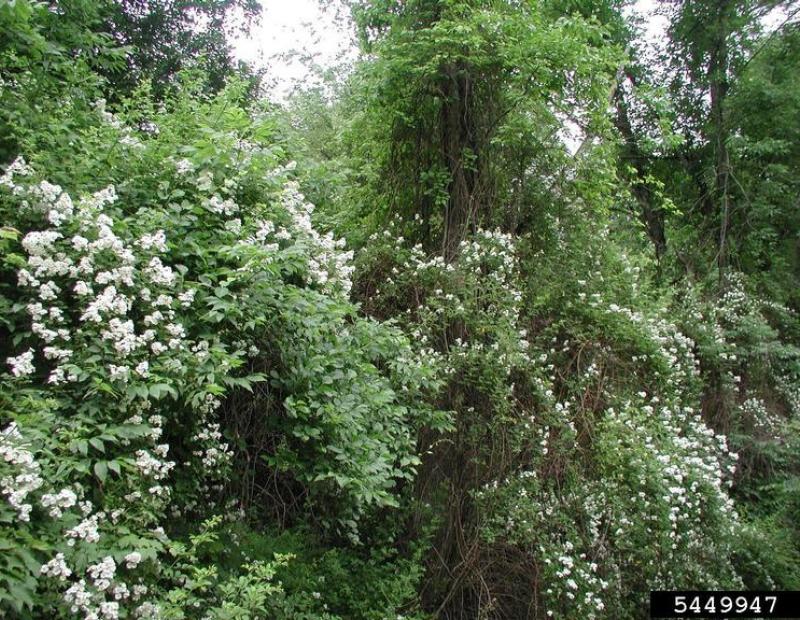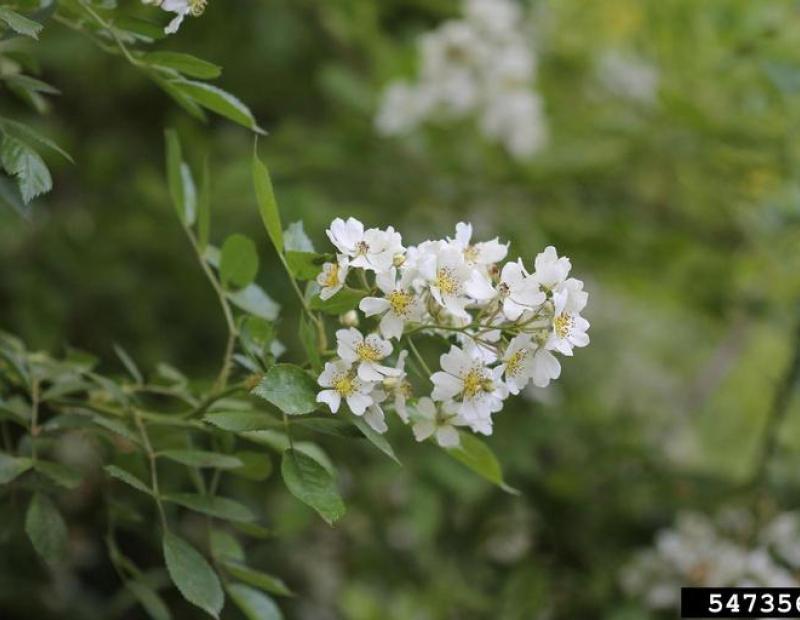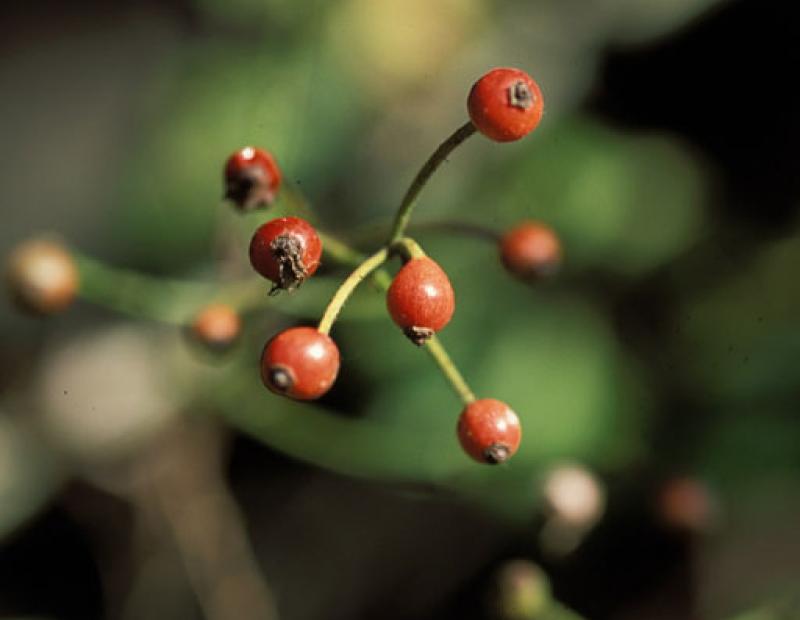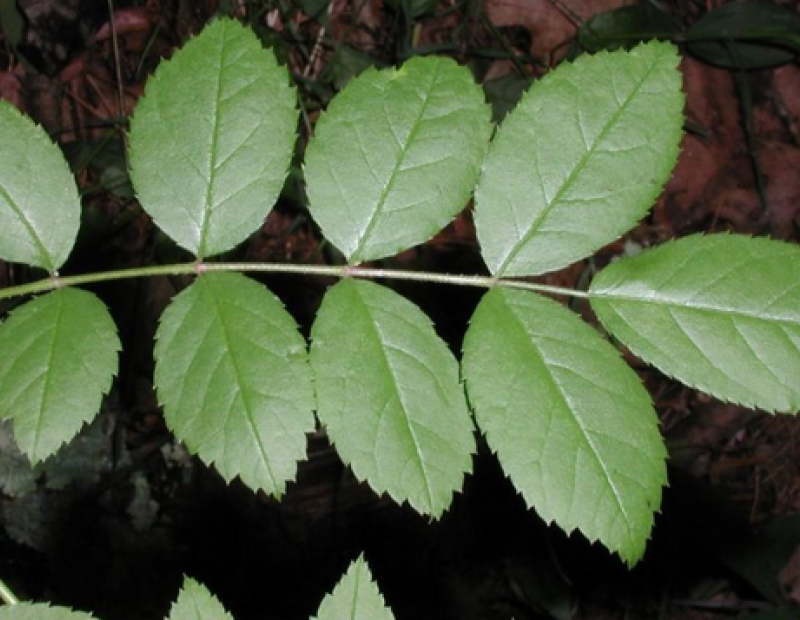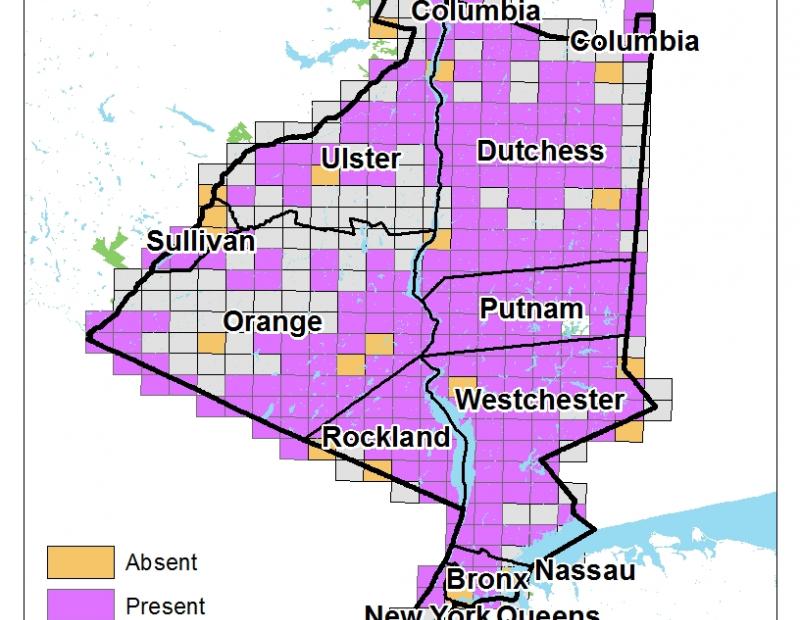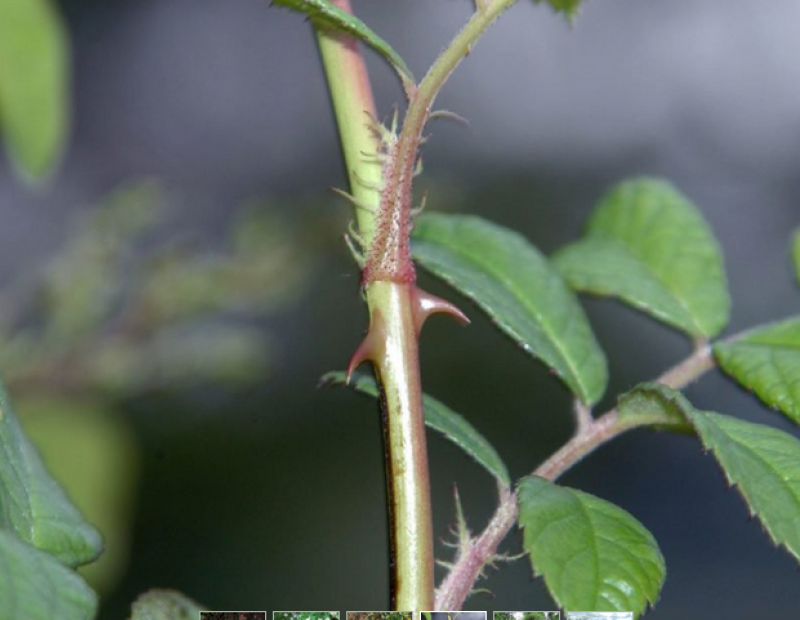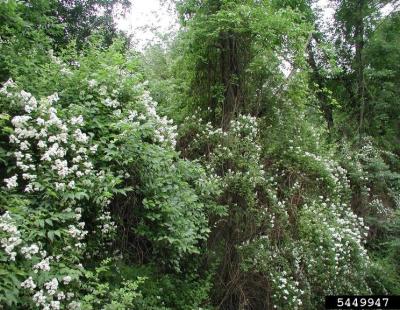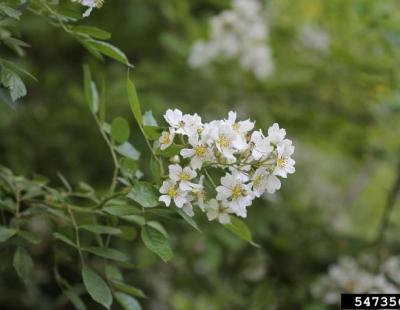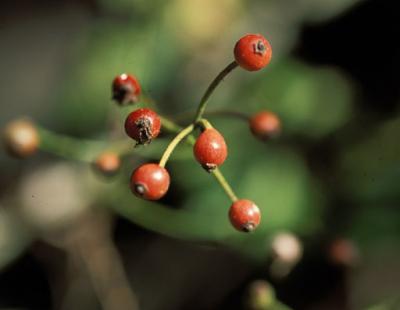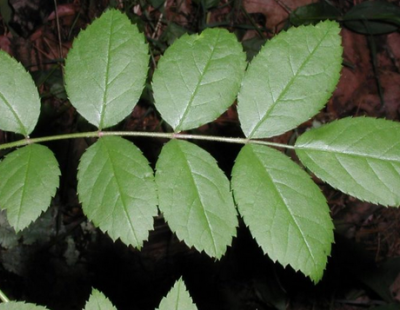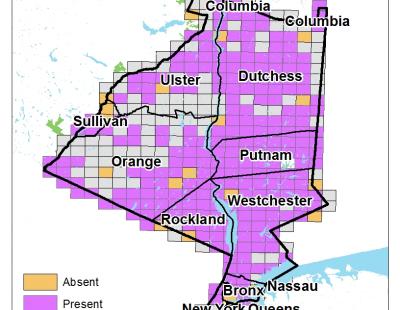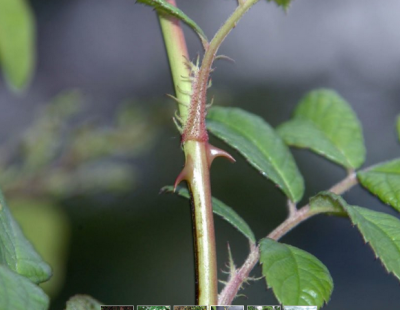Vertical Tabs
Rosa multiflora is a perennial shrub that typically grows to be between 1.8 to 3 meters tall, and is notable for its small white flowers that bloom in May or June. They have multiple arching stems that vary between green to red in color. Stiff, arching thorns are found along the length of the stems.The leaves of this plant are about 1-1.5 in. long, and compound with an average of 7-9 leaflets. They are oblong and have serated teeth along the edge of them. Small, red rose hips that are found on the plant persist through the winter. Its primary diagnostic feature that distinguishes it from native roses are the fringed stipules that are found at the base of each compound leaf.
This shrub grows vigorously, and often forms dense thickets, impenetrable by humans, outcompeting native plants for resources and space. It lowers pasture quality for cattle, replacing edible forage, and can lower crop yields in fields adjacent to a multiflora hedge (4) Multiflora rose can establish in forests, and may have a negative effect on native understory plant abundance or richness, but strong evidence is lacking. In a Midwestern deciduous forest, a negative trend in native understory plant richness was best explained by a combination of the densities of two nonnative earthworm species and cover of multiflora rose (5) Birds that nest in shrublands and forest understories often nest in multiflora. In some cases this has been shown to reduce nesting success compared to nesting in native shrubs (e.g., for northern cardinal and American robin in more developed areas). (6) In other cases this rose appears to provide good nesting habitat (e.g., for the same species in less developed areas (6) for veery in forest understory (7) and for gray catbird and chestnut-sided warbler in shrubland). (8) In an oldfield, higher densities of multiflora resulted in higher rates of maple seed predation due to the higher densities of white-footed mice (9) with implications for both altered forest regeneration and abundances of small mammals and their predators.
Multiflora rose provides high-quality habitat for many mammal and bird species, including mice, opossum, eastern cottontail, bobwhite, and songbirds. The hips are consumed by many species of birds including ruffed grouse, wild turkey, cedar waxwing, and American robin. Leaves and hips are consumed by many mammal species, and the hips may be especially valuable to wildlife in winter. (1) White-tailed deer can control multiflora rose to a certain extent by browsing; in a long-term exclosure experiment, multiflora was almost four times more abundant in the absence of deer. (10) Goats are even more effective browsers. (11) Multiflora rose and other invasive shrubs can provide important habitat for New England cottontail (a Special Concern species in NY) in shrublands and young forests. (12)
Manual or Mechanical Control
This page focuses on manual best management practices only. Please contact invasives@nynjtc.org with specific questions on chemical or biological control options.
- For eradication: Hand-pull or dig small plants (with shovel, weed wrench, or grubbing hoe), removing all roots as multiflora rose readily re-sprouts from root fragments. Any fruiting material should be bagged and landfilled.
- For eradication: Cut (along fences, in forests) or brush-hog (in fields, along forest edges) 3-6 times/year for at least 4 years, with regular monitoring thereafter. Seedlings may emerge from the seedbank for up to 20 years.
- Or try: In early spring, cut stems near ground level with a rotary wood shredder or brush saw. After stems resprout, follow this with directed flame treatment (when forest floor is damp or wet, use a propane torch to apply a direct flame for 3-40 seconds, until individual stems become carbonized and begin to glow). When used on Japanese barberry, one treatment (summer) with a 400K BTU torch resulted in about 80% mortality.18,19 This twostep process also minimizes soil disturbance and the chance of other invasive plants establishing.
- For preventing spread: Cut or brush-hog once a year, just after flowering. Large plants can be top cut with a saw or brush cutter, then mowed annually.
- For preventing spread: Graze goats or goats and cattle to restore and maintain heavilyinvaded pastures. Sheep and goats will feed on leaves, buds, and shoots of multiflora rose. In one study, goats alone or combined with cattle killed all or almost all multiflora rose shoots in infested pastures within four years. (11) However, root sprouts and seedlings were evident after 2 fallow years, so ongoing grazing may be necessary. Overgrazing, however, may make pastures more susceptible to colonization by multiflora rose and other invasive plants.
- Monitor un-infested as well as treated areas regularly and remove new plants.
- Consider leaving plants with rose rosette disease uncut (or experiment with cutting and placing diseased branches in healthy plants in early-mid July), to facilitate spread of this potential control agent. Alternatively, if protection of nearby cultivated roses is a goal, remove all nearby multiflora rose at the first sign of infection and dispose of plant parts offsite.
Management Goals
- Eradicate small patches or single shrubs.
- For large or extensive occurrences, limit spread by preventing fruiting each year.
- If occurrence is part of a large oldfield or shrubland potentially important to New England cottontail (only east of the Hudson River) or declining grassland- or shrubland-nesting birds such as yellow-breasted chat, golden-winged warbler, or northern harrier, discuss management with NYS DEC or appropriate conservation organizations (removal might not be desirable).
REFERENCES
- Munger, G.T. 2002. Rosa multiflora. In: Fire Effects Information System. U.S. Department of Agriculture, Forest Service, Rocky Mountain Research Station, Fire Sciences Laboratory. http://www.fs.fed.us/database/feis/ [Accessed 10 November, 2016].
- Banasiak, S.E., A.E. Scott, and J. Meiners. 2009. Long term dynamics of Rosa multiflora in a successional system. Biological Invasions 11:215–224.
- Callinger, K., E. Calhoon, H. Chang, J. Whitacre, J. Wenzel, L. Comita, and S. Queenborough. 2015. Historic mining and agriculture as indicators of occurrence and abundance of widespread invasive plant species. PLoS ONE 10(6): e0123161.
- Ekhart, N. 2001. Element stewardship abstract for Rosa multiflora. The Nature Conservancy, Arlington, VA.
- Gibson, K.D., P.M. Quackenbush, N.C. Emery, M.A. Jenkins, and E.J. Kladivko. 2013.Invasive earthworms and plants in Indiana old- and second-growth forests. Invasive Plant Science and Management 6:161-174.
- Borgman, K.L., and A.D. Rodewald. 2004. Nest predation in an urbanizing landscape: The role of exotic shrubs. Ecological Applications 14:1757-1765.
- Meyer, L.M., K.A. Schmidt, and B.A. Robertson. 2015. Evaluating exotic plants as evolutionary traps for nesting Veeries. The Condor 117:320-327.
- Schlossberg, S., and D.I. King. 2010. Effects of invasive woody plants on avian nest site selection and nesting success in shrublands. Animal Conservation 13:286-293.
- Meiners, S.J. 2007. Apparent competition: An impact of exotic shrub invasion on tree regeneration. Biological Invasions 9:849-855.
- Shen, X., N.A. Bourg, W.J. McShea, and B.L. Turner. 2016. Long-term effects of white-tailed deer exclusion on the invasion of exotic plants: A case study in a mid-Atlantic temperate forest. PLoS ONE 11: e0151825.
- Luginbuhl, J-M., T.E. Harvey, J.T. Green, Jr., M.H. Poore, and J.P. Mueller. 1999. Use of goats as biological agents for the renovation of pastures in the Appalachian region of the United States. Agroforestry Systems 44: 241–252.
- Litvaitis, J.A., J.L. Normetn, K. Boland, K. O’Brien, R. Stevens, D. Keirstead, T. Less, J.D. Oehler, J.M. Taylor, S. Bickford, and M.D. Tarr. 2013. Toward consensus-based actions that balance invasive plant management and conservation of at-risk fauna. Environmental Management 52:1313-1319.
- Epstein, A.H., and J.H. Hill. 1999. Status of rose rosette disease as a biological control for multiflora rose. Plant Disease 83:92-101.
- Rose rosette disease (website). In Biological control of weeds: A world catalogue of agents and their target weeds. http://www.ibiocontrol.org/catalog/view.cfm?id=2002 [Accessed 11/22/16]. Based on: Winston, R.L., M. Schwarzländer, H.L. Hinz, M.D. Day, M.J.W. Cock, and M.H. Julien, Eds. 2014. Biological Control of Weeds: A World Catalogue of Agents and Their Target Weeds, 5th edition. USDA Forest Service, Forest Health Technology Enterprise Team, Morgantown, West Virginia. FHTET-2014-04. 838 pp.

